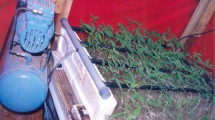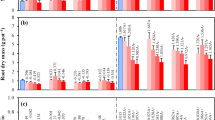Abstract
White lupin plants (Lupinus albus L. cv. Kiev) were grown in soil columns under controlled conditions at 20/12 °C (12/12 h) for 76 d to investigate the effect of phosphorus (P) deficiency on root-induced acidification and excess cation uptake by N2-fixing plants. Phosphorus was added in each column as FePO4 at a level of 10 (limited P) or 200 μg P g−1 (adequate P). Supply of 10 μg P g−1 restricted plant growth from 58 d after sowing (DAS) and decreased P concentrations significantly in shoots from 49 DAS and in roots from 40 DAS compared with plants supplied with 200 μg P g−1. Phosphorus concentrations in shoots of plants receiving 10 μg P g−1 decreased steadily from 2.1 to 1.1 mg P g−1 dry weight from 40 to 76 DAS, but P concentrations in roots were constant with time. Total P uptake increased with time irrespective of P supply, and the P uptake by plants at 10 μg P g−1 was only 35–75% of that at 200 μg P g−1. Plants fed with 10 μg P g−1 had higher Ca and Mg concentrations but lower S concentration in shoots than the plants fed with 200 μg P g−1. The concentrations of excess cations in plants were higher at 10 μg P g−1 than 200 μg P g−1 after 49 DAS. Phosphorus deficiency decreased the pH of root exudate solution due to the enhanced release of protons (H+) from roots. The pH of root exudate solution decreased rapidly with time and dropped to the lowest (4.28) at 58 DAS in the 10 μg P g−1 treatment. The decreased pH of root exudate solution was correlated with the increased concentrations of excess cations in plants. The pH of root exudate solution showed a different pattern of change with time compared with citrate exudation, suggesting that exudation of citrate anions contributes only a part of total acidification, but excess cation uptake dominantly contributes net proton release from roots of plants grown in P-deficient soil. Plant tissue had a significant accumulation of citrate in the treatment of 10 μg P g−1 compared with 200 μg P g−1 after 67 DAS. The results suggest that P deficiency enhances the excess cation uptake and concomitant proton release, and non-synchronous processes are involved in tissue accumulation and root exudation of organic anions under P deficiency.
Similar content being viewed by others
References
Barber S A 1984 Soil Nutrient Bioavailability: A mechanistic approach. John Wiley & Sons, Inc. New York. 398 p.
Brennan R F, Gartrell J W and Robson A D 1980 Reactions of copper with soil affecting its availability to plants. I. Effect of soil type and time. Aust. J. Soil Res. 18, 447–459.
Dinkelaker B, Romheld V and Marschner H 1989 Citric acid ex-cretion and precipitation of calcium in the rhizosphere of white lupin (Lupinus albus L.). Plant Cell Environ. 12, 285–292.
Dinkelaker B, Hengeler C and Marschner H 1995 Distribution and function of proteoid roots and other root clusters. Bot. Acta. 108,183–200.
Dracup M N H, Barrett-Lennard E G, Greenway H and Robson A D 1984 Effect of phosphorus deficiency on phosphatase activity of cell walls from roots of subterranean clover. J. Exp. Bot. 35, 466–480.
Föhse D, Classen N and Jungk A 1991 Phosphorus efficiency of plants. II. Significance of root radius, root hairs and cation-anion balance for phosphorus influx in seven plant species. Plant Soil 132, 261–272.
Gardner W K, Barber D A and Parbery K G 1983 The acquisition of phosphorus by Lupinus albus L. III. The probable mechan-ism by which phosphorus movement in the soil/root interface is enhanced. Plant Soil 70, 107–124.
Gerke J, Roemer W and Jungk A 1994 The excretion of citric and malic acid by proteoid roots of Lupinus albus L. Effect on soil solution concentrations of phosphate, iron and aluminium in the proteoid rhizosphere in samples of an oxisol and luvisol. Z. Pflanzenernähr. Bodenkd. 157, 289–294.
Hedley M J, White R E and Nye P H 1982 Plant-induced changes in the rhizosphere of rape (Brassica napus var. Emerald) seedlings. III. Changes in L value, soil phosphate fractions and phosphatase activity. New Phytol. 91, 45–56.
Hinsinger P 1998 How do plant roots acquire mineral nutrients? Chemical properties involved in the rhizosphere. Adv. Agron. 64, 225–265.
Hinsinger P 2001 Bioavailability of soil inorganic P in the rhizo-sphere as affected by root-induced chemical changes: A review. Plant Soil 237, 173–195.
Hinsinger P, Plassard C, Tang C and Jaillard B 2003 Origins of root-mediated pH changes in the rhizosphere and their responses to environmental constraints: A review. Plant Soil 248, 43–59.
Johnson C M and Ulrich A 1959 Analytical methods for use in plant analysis. Cali. Agric. Exp. Stat. Bull. No. 766.
Johnson J F, Allan D L and Vance C P 1994 Phosphorus stress-induced proteiod roots show altered metabolism in Lupinus albus. Plant Physiol. 104, 657–665.
Johnson J F, Allan D L, Vance C P and Weiblen G 1996a Root carbon dioxide fixation by Phosphorus-deficient Lupinus albus. Contribution to organic acid exudation by proteoid roots. Plant Physiol. 112, 19–30.
Johnson J F, Vance C P and Allan D L 1996b Phosphorus deficiency in Lupinus albus. Altered lateral root development and enhanced expression of phosphoenolpyruvate carboxylase. Plant Physiol. 112, 31–41.
Jones D L 1998 Organic acids in the rhizosphere – A critical review. Plant Soil 205, 25–44.
Kamh M, Horst W J, Amer F, Mostafa H and Maier P 1999 Mobil-ization of soil and fertilizer phosphate by cover crops. Plant Soil 211, 19–27.
Keerthisinghe G, Hocking P J, Ryan P R and Delhaize E 1998 Effect of phosphorus supply on the formation and function of proteoid roots of white lupin (Lupinus albus L.). Plant Cell Environ. 21, 467–478.
Lamont B B 2003 Structure, ecology and physiology of root clusters – A review. Plant Soil 248, 1–19.
Li M, Shinano T and Tadano T 1997 Distribution of exudates of lupin roots in the rhizosphere under phosphorus deficient conditions. Soil Sci. Plant Nutr. 43, 237–245.
Ma Z, Bielenbery D G, Brown K M and Lynch J P 2001 Regulation of root hair density by phosphorus availability in Arabidopsis thaliana. Plant Cell Environ. 24, 459–467.
Marschner H 1995 Mineral Nutrition of Higher Plants. 2nd Edition. Academic Press, London. 889 pp.
Neumann G and Römheld V 1999 Root excretion of carboxylic acids and protons in phosphorus-deficient plants. Plant Soil 211, 121–130.
Neumann G, Massonneau A, Martinoia E and Römheld V 1999 Physiological adaptations to phosphorus deficiency during pro-teoid root development in white lupin. Planta 208, 373–382.
Neumann G, Massonneau A, Langlade N, Dinkelaker B, Hengeler Ch, Römheld V and Martinoia E 2000 Physiological aspects of cluster root function and development in phosphorus-deficient white lupin (Lupinus albus L.). Ann. Bot. 85, 909–919.
Northcote K H 1971 A Factual Key for the Recognition of Aus-tralian Soils. Rellim, Glenside, South Australia.
Raghothama K G 1999 Phosphate acquisition. Annu. Rev. Plant Physiol. Plant Mol. Biol 50, 665–693.
Ryan P R and Delhaize E 2001 Function and mechanism of organic anion exudation from plant roots. Annu. Rev. Plant Physiol. Plant Mol. Biol. 52, 527–560.
Sas L, Tang C and Rengel Z 2001 Excess cation uptake, and ex-trusion of proton and organic acid anion by Lupinus albus under phosphorus deficiency. Plant Sci. 160, 1191–1198.
Shane M W, De Vos M, De Roock S and Lambers H 2003 Shoot phosphorus status regulates citrate exudation and cluster-root growth in divided root systems of Lupinus albus. Plant Cell Environ. 26, 265–273.
Shen J, Rengel Z, Tang C and Zhang F 2003 Role of phosphorus nu-trition in development of cluster roots and release of carboxylates in soil-grown Lupinus albus. Plant Soil 248, 199–206.
Smith S E, Robson A D and Abbott L K 1992 The involvement of mycorrhizas in assessment of genetically dependent efficiency of nutrient uptake and use. Plant Soil 146, 169–179.
SPSS 1998 Standard version. SPSS Inc.
Tang C, McLay C D A and Barton L 1997 A comparison of proton excretion of 12 pasture legumes grown in nutrient solution. Aust. J. Exp. Agric. 37, 563–570.
Tang C, Hinsinger P, Drevon J J and Jaillard B 2001 Phosphorus deficiency impairs early nodule functioning and enhances proton release in roots of Medicago truncatula L. Ann. Bot. 88, 131–138.
Veneklaas E J, Stevens J, Cawthray G R, Turner S, Grigg A M and Lambers H 2003 Chickpea and white lupin rhizosphere carboxylates vary with soil properties and enhance phosphorus uptake. Plant Soil 248, 187–197.
Watt M and Evans J R 1999a Linking development and determinacy with organic acid efflux from proteoid roots of white lupin growth with low phosphorus and ambient or elevated atmospheric CO 2 concentration. Plant Physiol. 120, 705–716.
Watt M and Evans J R 1999b Proteoid roots: Physiology and development. Plant Physiol. 121, 317–323.
Westerman R L 1990 Soil testing and plant analysis. 3rd edition. American Society of Agronomy and Soil Science Society of America, Madison, Wisconsin.
Yan F, Zhu Y, Müller C, Zörb C and Schubert S 2002 Adaptation of H +-pumping and plasma membrane H +ATPase activity in proteoid roots of white lupin under phosphate deficiency. Plant Physiol. 129, 50–63.
Author information
Authors and Affiliations
Rights and permissions
About this article
Cite this article
Shen, J., Tang, C., Rengel, Z. et al. Root-induced acidification and excess cation uptake by N2-fixing Lupinus albus grown in phosphorus-deficient soil. Plant and Soil 260, 69–77 (2004). https://doi.org/10.1023/B:PLSO.0000030172.10414.e6
Issue Date:
DOI: https://doi.org/10.1023/B:PLSO.0000030172.10414.e6




